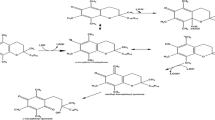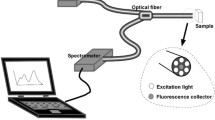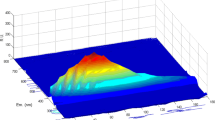Abstract
Combined methods of fluorescence spectrometry with chemometrics were used to monitor oxidation deterioration of edible oil. Synchronous and three dimensional fluorescence spectroscopy techniques were proposed for monitoring palm oil, camellia oil, sunflower oil and perilla oil during oven accelerated oxidation. Principal component analysis plot of fluorescence intensity (λex = 320–700 nm) clearly showed oxidative evolution of oils over heating time. High saturated or monounsaturated oils exhibited high regression coefficients between peroxide values and fluorescence intensity (R 2 = 0.973 for 400 nm in palm oil; R 2 = 0.956 for 370 nm in camellia oil). High diunsaturated oil exhibited high regression coefficient between nonpolar carbonyl compounds and fluorescence intensity (R 2 = 0.970 for 370 nm in sunflower oil). High triunsaturated oil exhibited high regression coefficient between p-anisidine value and fluorescence intensity (R 2 = 0.938 for 665 nm in perilla oil). In conclusion, Fluorescence spectroscopy is a rapid and green nondestructive method for oxidation monitoring. Differences of fatty acid compositions played key rules in formation of oxidation products and evolution of fluorescence spectra.






Similar content being viewed by others
Abbreviations
- 3D:
-
three dimensional
- AV:
-
acid value
- EEM:
-
excitation–emission matrices
- EX:
-
excitation
- EM:
-
emission
- GC:
-
gas chromatography
- HPLC:
-
high performance liquid chromatography
- ICA:
-
independent component analysis
- PCA:
-
principal component analysis
- PARAFAC:
-
parallel factor analysis
- POV:
-
peroxide value
- p-AV:
-
p-anisidine value
- TBA:
-
thiobrabituric acid value
- TNC:
-
total nonpolar carbonyl value
References
Ammari F, Cordella CBY, Boughanmi N, Rutledge DN (2012a) Independent components analysis applied to 3D-front-face fluorescence spectra of edible oils to study the antioxidant effect of Nigella sativa L. Extract on the thermal stability of heated oils. Chemom Intell Lab Syst 113:32–42
Ammari F, Jouan-Rimbaud-Bouveresse D, Boughanmi N, Rutledge DN (2012b) Study of the heat stability of sunflower oil enriched in natural antioxidants by different analytical techniques and front-face fluorescence spectroscopy combined with independent components analysis. Talanta 99:323–329
Aubourg SP (2001) Fluorescence study of the pro-oxidant effect of free fatty acids on marine lipids. J Sci Food Agric 81:385–390
Aubourg S, Medina I, Pérez-Martín R (1995) A comparison between conventional and fluorescence detection methods of cooking-induced damage to tuna fish lipids. Z Lebensm Unters Forsch 200:252–255
Aubourg SP, Sotelo CG, Pérez-Martín R (1998) Assessment of quality changes in frozen sardine (Sardina pilchardus) by fluorescence detection. J Am Oil Chem Soc 75:575–580
Bro R, van den Berg F, Thybo A, Andersen CM, Jørgensen BM, Andersen H (2002) Multivariate data analysis as a tool in advanced quality monitoring in the food production chain. Trends Food Sci Technol 13:235–244
Brühl L (2014) Fatty acid alterations in oils and fats during heating and frying. Eur J Lipid Sci Technol 116:707–715
Cao J, Deng L, Zhu XM, Fan Y, Hu JN, Li J, Deng ZY (2014a) Novel approach to evaluate the oxidation state of vegetable oils using characteristic oxidation indicators. J Agric Food Chem 62:12545–12552
Cao J, Zou XG, Deng L, Fan YW, Li H, Li J, Deng ZY (2014b) Analysis of nonpolar lipophilic aldehydes/ketones in oxidized edible oils using HPLC-QqQ-MS for the evaluation of their parent fatty acids. Food Res Int 64:901–907
Cert A, Moreda W, Pérez-Camino M (2000) Chromatographic analysis of minor constituents in vegetable oils. J Chromatogr A 881:131–148
Cheikhousman R, Zude M, Bouveresse DJR, Léger CL, Rutledge DN, Birlouez-Aragon I (2005) Fluorescence spectroscopy for monitoring deterioration of extra virgin olive oil during heating. Anal Bioanal Chem 382:1438–1443
Choe E, Min DB (2006) Mechanisms and factors for edible oil oxidation. Compr Rev Food Sci F 5:169–186
Christensen J, Povlsen V, Sørensen J (2003) Application of fluorescence spectroscopy and chemometrics in the evaluation of processed cheese during storage. J Dairy Sci 86:1101–1107
Christensen JH, Hansen AB, Mortensen J, Andersen O (2005) Characterization and matching of oil samples using fluorescence spectroscopy and parallel factor analysis. Anal Chem 77:2210–2217
Dupuy N, Le Dréau Y, Ollivier D, Artaud J, Pinatel C, Kister J (2005) Origin of French virgin olive oil registered designation of origins predicted by chemometric analysis of synchronous excitation-emission fluorescence spectra. J Agric Food Chem 53:9361–9368
Dziuban CD, Shirkey EC (1974) When is a correlation matrix appropriate for factor analysis? Some decision rules. Psychol Bull 81:358–361
Feudjio WM, Ghalila H, Nsangou M, Kongbonga YGM, Majdi Y (2014) Excitation-emission matrix fluorescence coupled to chemometrics for the exploration of essential oils. Talanta 130:148–154
Ge F, Chen C, Liu D, Zhao S (2014) Rapid quantitative determination of walnut oil adulteration with sunflower oil using fluorescence spectroscopy. Food Anal Methods 7:146–150
Guillen MD, Goicoechea E (2009) Oxidation of corn oil at room temperature: primary and secondary oxidation products and determination of their concentration in the oil liquid matrix from 1H nuclear magnetic resonance data. Food Chem 116:183–192
Guimet F, Ferré J, Boqué R (2005) Rapid detection of olive-pomace oil adulteration in extra virgin olive oils from the protected denomination of origin “Siurana” using excitation-emission fluorescence spectroscopy and three-way methods of analysis. Anal Chim Acta 544:143–152
Hu JN, Zhang B, Zhu XM, Li J, Fan YW, Liu R, Tang L, Lee KT, Deng ZY (2011) Characterization of medium-chain triacylglycerol (MCT)-enriched seed oil from Cinnamomum camphora (Lauraceae) and its oxidative stability. J Agric Food Chem 59:4771–4778
Kunz MR, Ottaway J, Kalivas JH, Georgiou CA, Mousdis GA (2011) Updating a synchronous fluorescence spectroscopic virgin olive oil adulteration calibration to a new geographical region. J Agric Food Chem 59:1051–1057
Kyriakidis NB, Skarkalis P (2000) Fluorescence spectra measurement of olive oil and other vegetable oils. J AOAC Int 83:1435–1439
Liang JH (1999) Fluorescence due to interactions of oxidizing soybean oil and soy proteins. Food Chem 66:103–108
Patra D, Mishra A (2002) Recent developments in multi-component synchronous fluorescence scan analysis. TrAC Trends Anal Chem 21:787–798
Poulli KI, Mousdis GA, Georgiou CA (2009a) Monitoring olive oil oxidation under thermal and UV stress through synchronous fluorescence spectroscopy and classical assays. Food Chem 117:499–503
Poulli KI, Chantzos NV, Mousdis GA, Georgiou CA (2009b) Synchronous fluorescence spectroscopy: tool for monitoring thermally stressed edible oils. J Agric Food Chem 57:8194–8201
Sikorska E, Górecki T, Khmelinskii IV, Sikorski M, Keukeleire D (2004) Fluorescence spectroscopy for characterization and differentiation of beers. J Inst Brew 110:267–275
Sikorska E, Górecki T, Khmelinskii IV, Sikorski M, Kozioł J (2005a) Classification of edible oils using synchronous scanning fluorescence spectroscopy. Food Chem 89:217–225
Sikorska E, Gliszczynska-Swiglo A, Khmelinskii I, Sikorski M (2005b) Synchronous fluorescence spectroscopy of edible vegetable oils. Quantification of tocopherols. J Agric Food Chem 53:6988–6994
Sikorska E, Khmelinskii IV, Sikorski M, Caponio F, Bilancia MT, Pasqualone A, Gomes T (2008) Fluorescence spectroscopy in monitoring of extra virgin olive oil during storage. Int J Food Sci Technol 43:52–61
Tena N, García-González DL, Aparicio R (2009) Evaluation of virgin olive oil thermal deterioration by fluorescence spectroscopy. J Agric Food Chem 57:10505–10511
Tobias S, Carlson JE (1969) Brief report: Bartletts test of sphericity and chance findings in factor analysis. Multivar Behav Res 4:375–377
Tomazzoni G, Meira M, Quintella CM, Zagonel GF, Costa BJ, de Oliveira PR, Pepe IM, da Costa Neto PR (2014) Identification of vegetable oil or biodiesel added to diesel using fluorescence spectroscopy and principal component analysis. J Am Oil Chem Soc 91:215–227
Valderrama P, Março PH, Locquet N, Ammari F, Rutledge DN (2011) A procedure to facilitate the choice of the number of factors in multi-way data analysis applied to the natural samples: application to monitoring the thermal degradation of oils using front-face fluorescence spectroscopy. Chemom Intell Lab Syst 106:166–172
Xu L, Xu X, Xiong H, Chen L, Li Y (2014) Rapid detection of vegetable cooking oils adulterated with inedible used oil using fluorescence quenching method with aqueous CTAB-coated quantum dots. Sensors Actuators B Chem 203:697–704
Zandomeneghi M, Carbonaro L, Calucci L, Pinzino C, Galleschi L, Ghiringhelli S (2003) Direct fluorometric determination of fluorescent substances in powders: the case of riboflavin in cereal flours. J Agric Food Chem 51:2888–2895
Acknowledgments
This study was supported by the Open Project Program of State Key Laboratory of Food Science and Technology, Nanchang University (No. SKLF-KF-201620), the Startup Fund Scientific Research Project, Hainan University (No. kyqd1608), and the National Natural Science Foundation of China (31071561).
Author information
Authors and Affiliations
Corresponding authors
Ethics declarations
Conflict of Interest
Jun Cao declares that she has no conflict of interest. Chuan Li declares that he has no conflict of interest. Rong Liu declares that she has no conflict of interest. Xiao-Ru Liu declares that she has no conflict of interest. Yawei Fan declares that she has no conflict of interest. Ze-Yuan Deng declares that he has no conflict of interest.
Ethical Approval
This article does not contain any studies with human participants or animals performed by any of the authors.
Informed Consent
Informed consent in this study is not applicable.
Rights and permissions
About this article
Cite this article
Cao, J., Li, C., Liu, R. et al. Combined Application of Fluorescence Spectroscopy and Chemometrics Analysis in Oxidative Deterioration of Edible Oils. Food Anal. Methods 10, 649–658 (2017). https://doi.org/10.1007/s12161-016-0587-2
Received:
Accepted:
Published:
Issue Date:
DOI: https://doi.org/10.1007/s12161-016-0587-2




